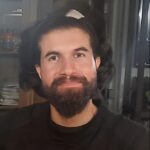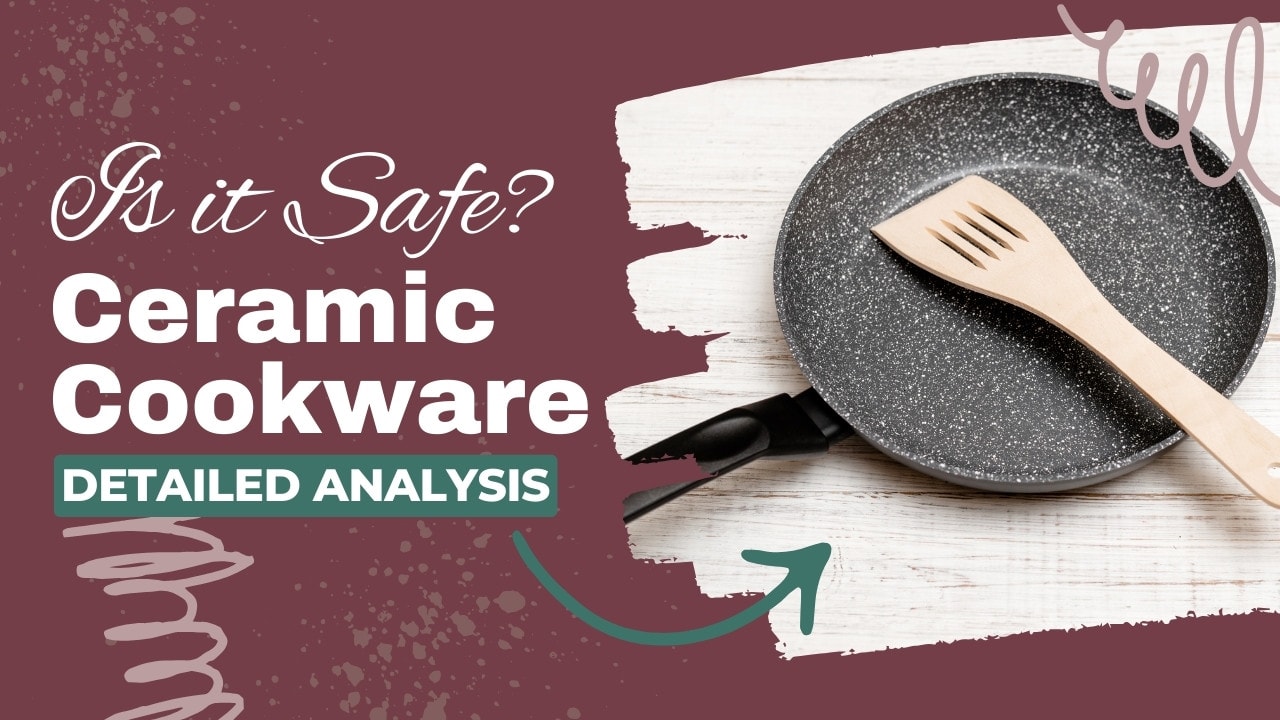Ceramic-coated cookware is quickly outpacing the popularity of nonstick pans. With a metal core and a silica-based coating, it claims to offer a natural, eco-friendly, and healthy alternative to traditional non-stick pans that use chemical polymer (Teflon) coatings.
But is ceramic cookware safe to use? Does it contain toxic metals like lead or cadmium? Could it suffer thermal shock and explode all over your kitchen? Is it really safer than Teflon coatings? And what about traditional or pure ceramic cookware that doesn’t have a metal core?
In this article, we will answer these questions and more, based on the latest research, expert opinions, and user reviews.
We will also provide you with some tips on how to care for and maintain your ceramic cookware, so you can enjoy its benefits for a long time.
What is Ceramic Cookware?
Ceramic cookware has a nonstick cooking surface made from sand-derived silicon. The coating is often infused with metals or minerals such as titanium, diamond, or granite. Ceramic cookware usually has an aluminum or stainless steel core.
Ceramic cookware is different from traditional or pure ceramic cookware, which is made from clay and quartz sand fired at high temperatures and then glazed.
Is Ceramic Cookware Safe?
As we discuss the safety of ceramic cookware, we need to be 100% clear that this article is primarily talking about metal cookware with nonstick ceramic coatings – for example GreenPan or Blue Diamond brand cookware.

This type of ceramic cookware is, according to a medical-doctor-reviewed article at Healthline, “Most likely safe.” It is worth noting that ceramic cookware is a relatively new technology and we don’t know as much about it as other forms of cookware. It has taken the market by storm as a “non-toxic” alternative to Teflon nonstick, but the research studies haven’t caught up yet to 100% verify that claim.
We do know that there are valid concerns about using full clay ceramic ware made with traditional methods. The clay itself and the glazing materials on artisan-made ceramic (clay-based) cookware have been linked to lead poisoning in New York City and many other locations.
If you are looking for a modern pure ceramic cookware that has been tested for contaminants, you might want to check out Xtrema cookware.
Nano-Ceramic Technology
The nanoparticles used in ceramic cookware technology create a bond between the metal’s surface and the ceramic coating, making it more durable.
Many have questioned the safety of nano-ceramic coatings on cookware, since nanoparticles can enter lung and cell tissue more easily than larger particles.
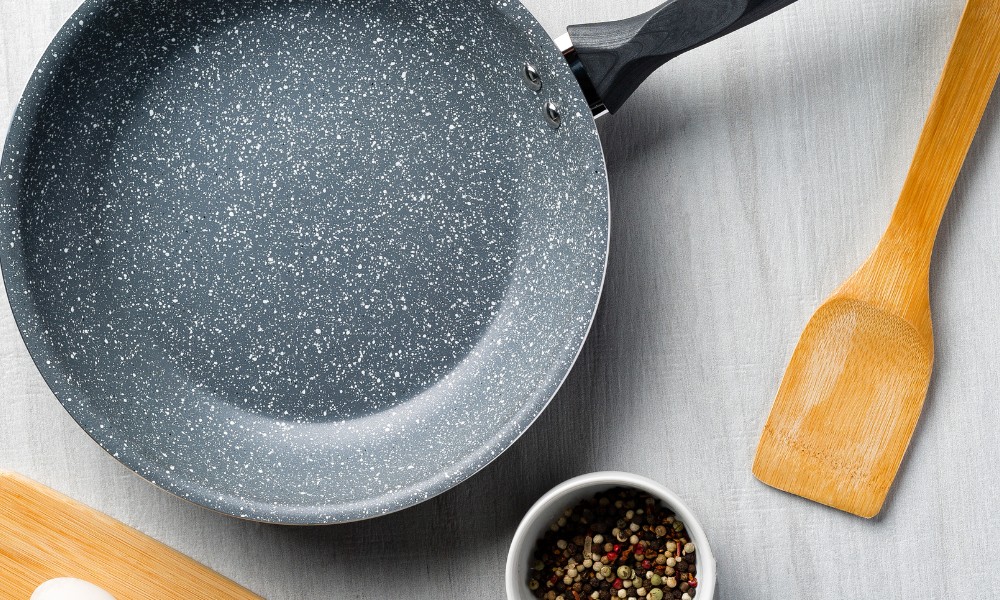
Nanoparticles seem to be most likely to be released from scratched cookware, according to this article from Food Packaging Forum, based on a 2016 study that looked at titanium and quartz nanoparticles released from ceramic pans.
This nanoparticle release is probably the biggest suspected health risk of ceramic cookware. More study is needed.
What is Ceramic Non-stick Cookware Made Of?
As mentioned, ceramic-coated non-stick cookware consists of a metal core coated with a layer of non-stick material. These metals can be:
What makes ceramic-coated cookware different from other non-stick products is the coating material. Ceramic-coated cookware has a coating made with sol-gel technology. The “sol” part of the name is short for “solution,” a solution of silica and water. Then, it’s formed into a gel in the manufacturing process and applied to the metal substrate.
Sol-gel involves a mixture of oxides that form a hard surface over the metal substrate of the pan. The gel component hardens over the surface and creates a glaze-like finish that gives the cookware its non-stick properties. It has a much higher heat tolerance than Teflon or traditional nonstick.
Different Types of Ceramic Coated Cookware
At the core, all Ceramic cookware manufacturers use the same sol-gel technology. However, different brands have developed proprietary coating products.
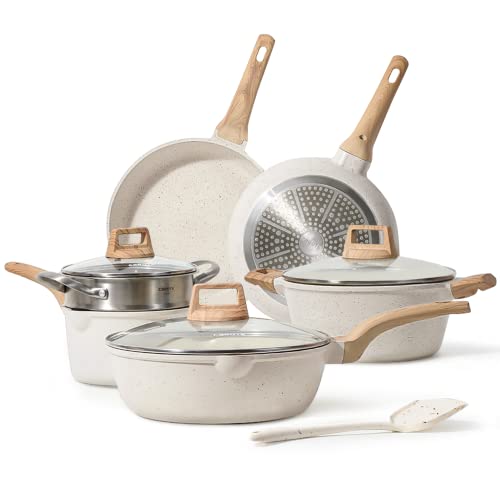
As you can see, although manufacturers use different ceramic patents, they all have the sol-gel process as their base.
They may have different finishes and glazes to create a protective coating over the ceramic layer. It makes ceramic cookware more durable and scratch-resistant. These glazes may contain diamond dust, titanium, granite, or copper to increase heat conduction, strength, and durability.
Is Ceramic Coated Cookware Safer than Nonstick Pans?
Ceramic-coated cookware is touted as an innovative solution offering a truly non-stick and healthy alternative to Teflon. The marketing has gone full bore on this “miraculous” cookware. But have the claims been verified? Is it safe to use?
PFOA and PTFE
First, let’s talk about why people choose ceramic over traditional nonstick coatings.
One of the main concerns about traditional non-stick cookware is the presence of “forever chemicals” or PFAS in polymer coatings. Perfluorooctanoic acid (PFOA) is one such highly persistent material linked with several known risks to the environment and human health. Teflon coatings, as originally formulated, contained PFOA. However, this particular chemical has been phased out in the US and was fully banned in 2015.
Newly manufactured cookware that complies with US regulations should not include any PFOA – whether it’s made of Teflon or not. (That said – watch out for cookware manufactured in China or countries without strict quality control.)
Traditional nonstick coatings, even if they don’t contain the branded product, “Teflon,” all still contain the generic fluoropolymer, polytetrafluoroethylene.
In fact, you can assume that any nonstick coating that isn’t ceramic is PTFE. Marketing material for nonstick pans will try to talk around this and will rarely mention that a pan contains PTFE. So if the marketing copy focuses on all the things that aren’t in the pan (such as PFOA) instead of what is in the pan, that can be a red flag.
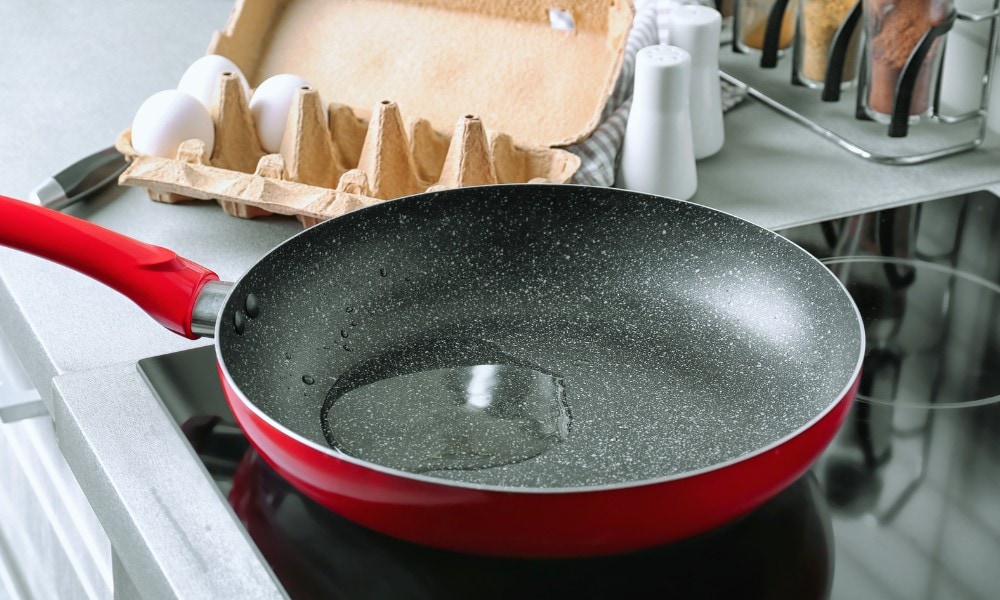
Even though PFOA is no longer used in the manufacturing of nonstick coatings, other chemicals have replaced it that could be just as bad – they’re just not as well-studied. In many “PFOA free” nonstick coatings, PFOA has been replaced by the environmentally-harmful chemical GenX.
Something has to give the coating that slippery texture – and it probably ain’t natural.
This is why many people choose the “probably safe” ceramic cookware made of “natural materials” (even if not a natural process) over the known risks of PTFE coatings.
Does Ceramic Cookware Contain PTFE, Teflon, or PFOA?
In most cases, no. Ceramic coating is a totally different technology than traditional nonstick. It should not contain “forever chemicals,” Teflon, or PTFE. But just because your ceramic-coated cookware’s label says PFOA-free, it doesn’t mean it’s completely risk-free. There are other factors to consider.
Heavy Metals
Lead, cadmium, and titanium are among the metals that can leach into food from cookware and pose health risks for certain individuals. Do ceramic-coated pans contain these metals?
Ceramic pans should be lead and cadmium-free. Lead is not used in the manufacturing process of ceramic-coated cookware like it is in the making of some true ceramics.
The FDA has strict regulations on leachable lead in cookware. ”Leachable” lead is lead that actually transfers to your food when using cookware.
According to its Closer to Zero program, cookware is tested on leachable lead – not necessarily whether it contains any lead. Any amount of lead leached into food will render the cookware not safe based on FDA standards.
Titanium
One study has shown that titanium nanoparticles can leach into food if you use abrasives to clean your ceramic-coated cookware. There’s no known evidence that titanium dioxide leaching from cookware can harm humans, but this still causes concern for many.
For example, GreenPan is a famous brand that uses Thermolon technology in its ceramic-coated cookware. It advertises its ceramic-coated cookware as toxin-free and 100% safe. However, there was a lawsuit in 2019 against GreenPan that disclosed several toxins used in their Thermolon coating. These include aluminum oxide and silane, among others.
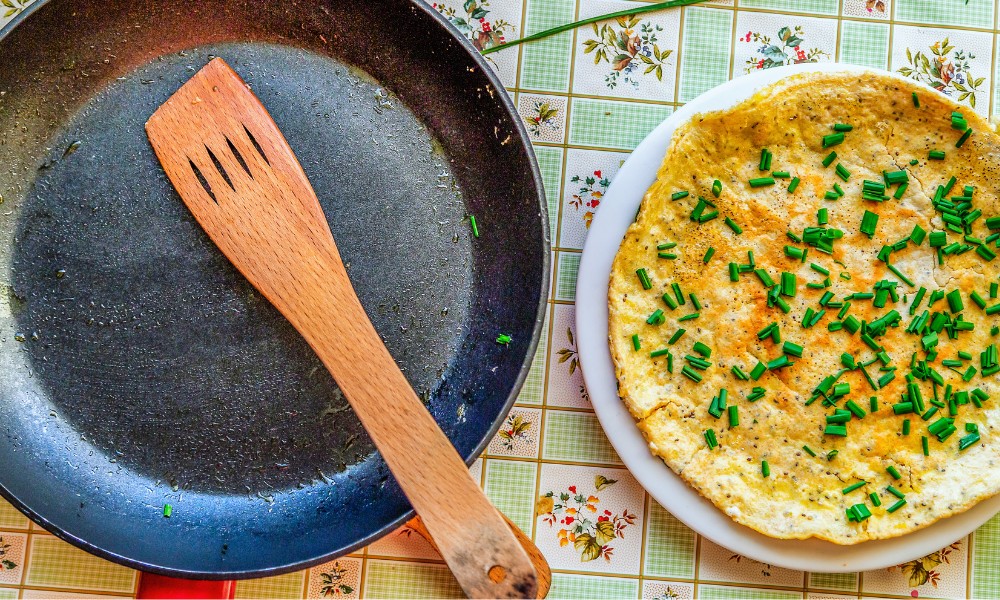
Although the case was dismissed, because there’s no evidence that these metals or chemicals will leach from the cookware into your food. But there’s no evidence that these toxins aren’t present in GreenPan’s products, either.
Watch Out for Hyperbolic Marketing Claims – Look for Test Results Instead
As a result of the 2019 lawsuit, GreenPan was admonished to not use over-the-top and unverified advertising claims, like to call their pans “healthy ceramic.” Because – of course – a pan itself cannot be “healthy” (you don’t eat pans!) and there’s no guarantee users will cook healthy meals in any kind of pan.
The point is that you should approach this issue on a case-by-case basis. Ceramic-coated cookware is a relatively new kid on the block. So, there’s little research on its safety.
Other brands, such as Caraway, have robust tests proving no harmful chemicals in their products. According to this video, Leigh Matthews, LeafScore’s researcher, reached out to Caraway, and they provided her with the test results you can view in the video below.
Leaching Substrate Metals
Another health concern related to ceramic-coated cookware is its core metals. As mentioned, aluminum, copper, and cast iron are the most common metals in ceramic-coated cookware. Should we be concerned about toxins migrating from the metal core into our food?
The short answer is no. High-quality ceramic-coated cookware contains several coats of hard ceramic to prevent contact between your food and these metals. This coating – if you don’t overheat it and keep it out of the dishwasher – can last at least a couple of years intact.
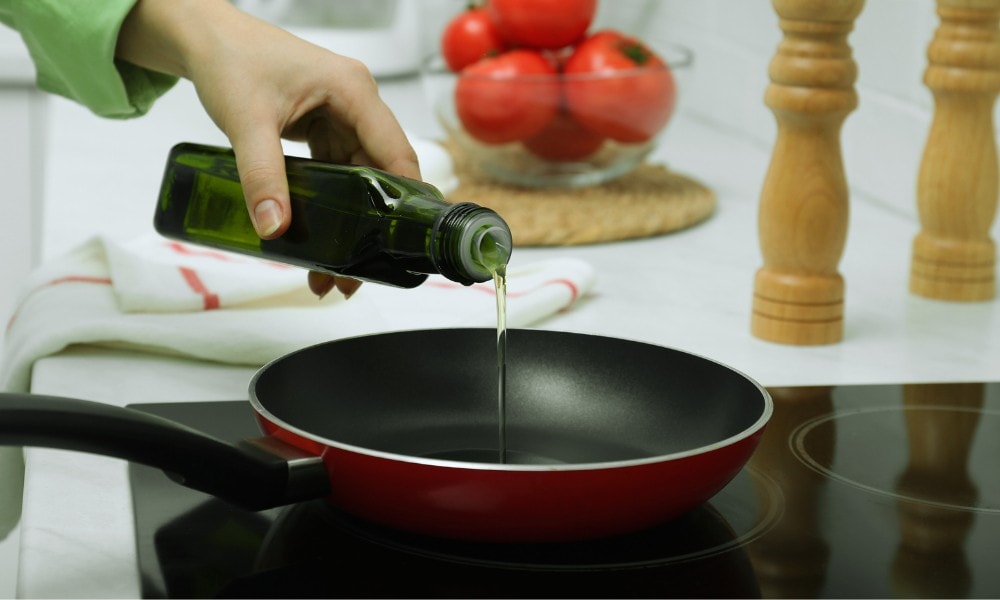
However, scratches are bound to appear on the cookware coating over time. These scratches can reach the underlying metal if they’re deep enough.
California Proposition 65 and New Regulations
California Proposition 65 has a long list of chemicals restricted to use in US-manufactured and imported cookware. This list is updated regularly and currently includes over 800 items. Some of the notable ones include:
California requires a warning label on the packaging of products that contain or may contain unsafe levels of any of these chemicals.
In January 2024, a new law will go into effect in California, requiring “manufacturers of cookware to disclose hazardous and intentionally added chemicals.”
This should shake up the state of cookware marketing, if manufacturers are required to disclose any “forever chemicals” used in cookware. Right now it can be very difficult to find out what is actually in your “totally healthy” pans.
Long story short: you may want to toss your ceramic cookware if you see scratches or flaking.
Is Sol-gel Safe?
Products made with the sol-gel technology are generally considered safe. The sol-gel process turns traditional ceramic materials into a hardened coating on a metal substrate. These materials are inorganic and sand-based.

The titanium and quartz nanoparticles in sol-gel coated pans shouldn’t leach into your food unless the pan is scratched or heated to above 900 degrees Fahrenheit. However, some manufacturers may add other chemicals to the sol-gel process to improve the nonstick ability or durability of their pans.
So, it’s recommended to check the sol-gel ingredients before purchasing. You may want to steer clear if the manufacturer doesn’t disclose these materials.
Is Pure Ceramic Cookware Non-Toxic?
Pure ceramic pots and pans may be confused with ceramic-coated ones.
Xtrema promises that its products are non-toxic. They publish their testing results every year, showing they’re compliant with California Prop 65.
These are the advantages of
Still, it has some drawbacks that make it a dealbreaker for some.
That said, it’s an excellent investment if you are looking for a healthy option that lasts a lifetime.
Glazed Ceramic Cookware
Modern ceramic and stoneware made by brands like

In a 2016 study, Dr. Michael Fralick and his colleagues reported a case of lead poisoning with symptoms like anemia, weakness, and abdominal pain. After a thorough examination, they found the culprit was a glazed ceramic mug and pot they had bought from Mexico. They found considerable amounts of lead in the glazing material.
Another study revealed that imported ceramic dishes contain harmful chemicals beyond the safe levels allowed by FDA. So, ensure the pottery and ceramic cookware you purchase comply with FDA regulations and come from a reliable source.
How to Use and Maintain Ceramic Cookware
Ceramic-coated cookware is easy to use, but a bit high-maintenance compared to other materials like stainless steel. The coating can get damaged or lose its non stick properties if you don’t follow recommended care practices.
Here’s what to do:
Check out this video to see how to wash your ceramic-coated pans.
How Long Does Your Nonstick Ceramic-coated Pan Last?
When it comes to lifespan, ceramic-coated doesn’t shine as much as others. You may enjoy their exceptional nonstick qualities, getting that sunny-side-up egg sliding right off the pan. But don’t expect it to last a lifetime. If taken care of properly, high-quality ceramic-coated pans last 2-3 years.
Manufacturers offer a wide range of warranty periods, which can indicate their products’ lifespan. For example, Cuisinart offers a lifetime warranty for US customers, while it’s only a one-year limited warranty for Caraway. But normally, you can find 3-5 year warranties from many brands.
If you take proper care of your ceramic cookware, it may even last longer. But most will lose their nonstick properties after three years, maximum. You may not see visible scratches or damage, but food will stick to it if you don’t use enough oil.
What are the Advantages of Ceramic Non-stick Cookware?
If you’re in the market for nonstick cookware, ceramic is a strong option to consider. These products are a superior choice over many other alternatives, including Teflon. They’re nonstick and heat evenly if they have a thick aluminum core. But the advantages to ceramic cookware don’t end here.
Is Ceramic Cookware Environmentally Friendly?
Ceramic cookware may be more environmentally friendly than Teflon. The jury is still out on the “green” claims made by some ceramic cookware manufacturers – and the truth is that any mass-produced cookware will take a large amount of natural resources.
But since it’s made with natural materials and does not contain “forever chemicals”, ceramic nonstick may be better for the environment than PTFE nonstick pans. The manufacturing chain may be shorter, requiring less energy.
That said, ceramic-coated pans rarely last more than 2-3 years, and then usually end up in a landfill. Stainless steel, cast iron, and carbon steel that can last for decades are a “greener” choice in that respect.

What Are the Best Brands of Ceramic-coated Cookware?
Finding the best ceramic cookware brands isn’t challenging these days, since there are so many good options on Amazon.com.
These are, in my opinion, the best brands of ceramic cookware in the market:
Caraway
Caraway sets itself apart through its unique aesthetics as one of the most reputable brands. The sleek design is a great addition to your kitchen decor, mixing functionality with beauty. The set comes in a wide range of colors, enabling you to match your kitchen colors.

The accompanying storage solutions and lid racks are also convenient options that allow you to stack the pots and pans without damaging them.
Cuisinart
Cuisinart ceramic cookware is made with their patented Ceramica technology with titanium-reinforced glazes.
Cuisinart offers a lifetime warranty on its ceramic products, staying true to the Cuisinart quality and workmanship.
What Are the Best Brands of Pure Ceramic Cookware
Earlier in this article, I mentioned
LeCreuset
As one of the oldest cookware brands, LeCreuset has been around for over 100 years, offering high-end and quality cookware.
It makes pure ceramic cookware with a mixture of clay and sand quartz. So, it’s non-toxic, durable, and oven-safe, tolerating high heat.

They also offer a wide range of cast iron pots and pans with interior coatings that look like ceramic. But they’re enamel-coated and different from ceramic.
LeCreuset’s pure ceramic cookware is perfect for baking and oven use – but not stovetop. So, if you want cookware for searing and frying, you should check out Xtrema.
What Are the Alternatives to Ceramic Cookware?
Although ceramic-coated cookware is one of the safest options for nonstick cookware, some people prefer other materials. They simply want lower maintenance products or seek higher durability from their cookware. For those, the following alternatives are better:
Frequently Asked Questions about Ceramic Cookware Safety
Is 100% ceramic cookware the safest?
Pure ceramic cookware is among the safest cookware options. It doesn’t contain a metal core, but is made 100% with clay and sand. And since it’s baked at extremely high temperatures, known as vitrification, it becomes scratch-resistant and non-reactive. You do need to check third-party testing certification to make sure it doesn’t contain lead.
Is Teflon safer than ceramic?
It depends on who you ask. Some people will say Teflon is safe if used correctly – that is, not scratched or overheated. The primary concern with ceramic cookware is nanoparticle release, and the primary concern with Teflon cookware is the “forever chemicals” used in its manufacturing. Both may be harmful for the environment as well.
Conclusion
Ceramic-coated pots and pans can be a safe alternative to traditional non-stick cookware if you get them from a reliable brand. These brands must be transparent about their ingredients and comply with FDA standards. Although nonstick ceramic cookware doesn’t contain PTFE, it may introduce chemicals in the sol-gel process.
Have you ever purchased ceramic-coated cookware? Please share your experiences with us in the comments below.
